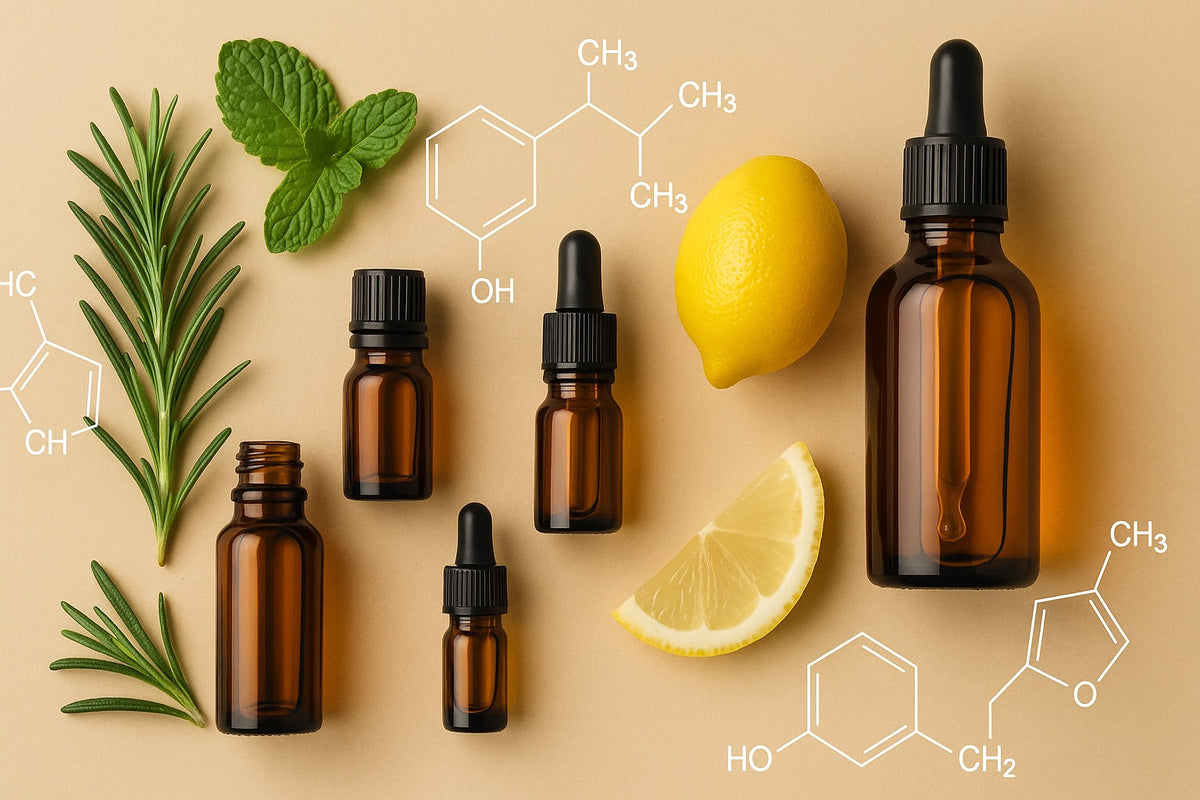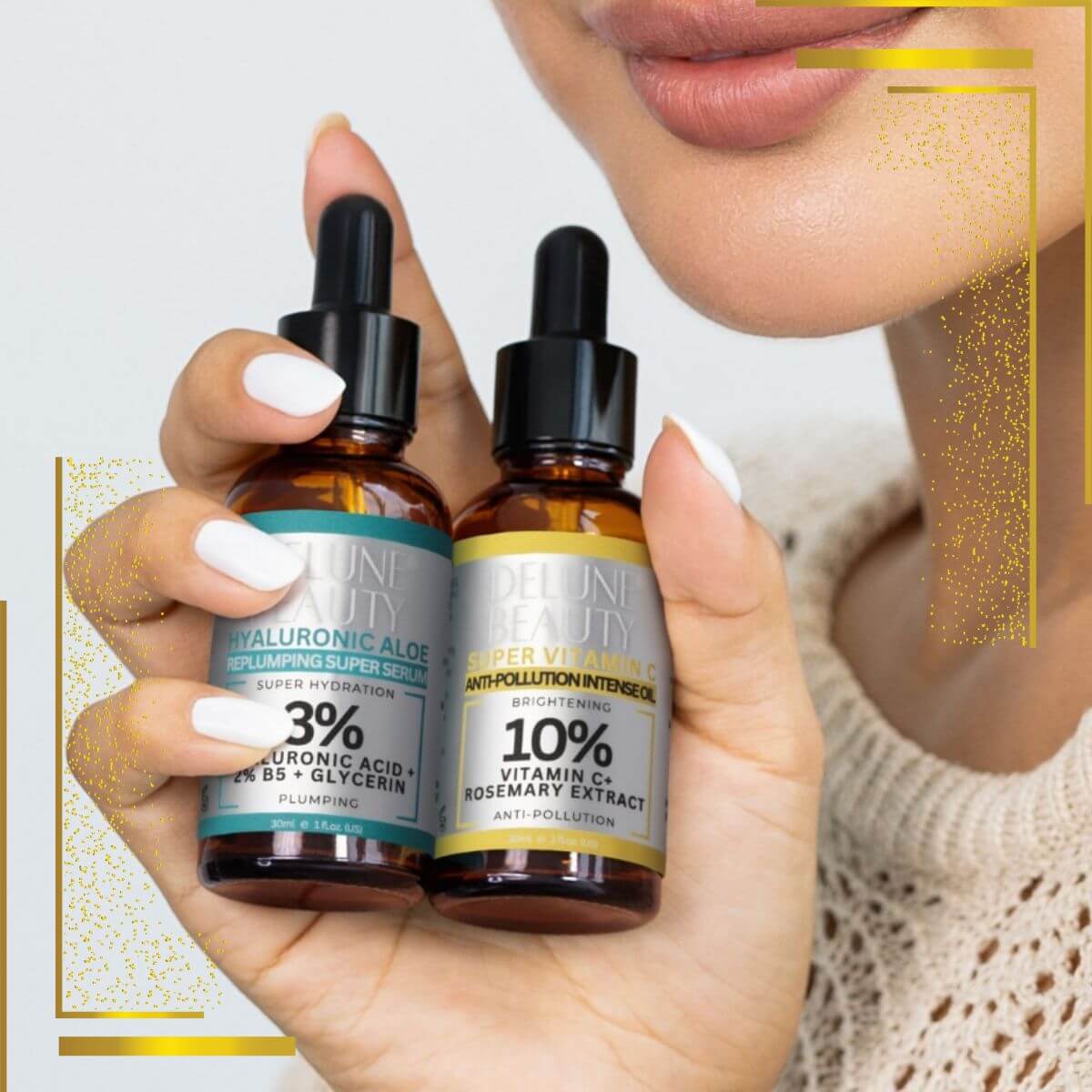
علم الزيوت العطرية: ما هي مكوناتها وأهميتها
|
وقت القراءة 3 min

نظيف، واعٍ، وملهم سريريًا. تم تصميم Delune Skincare للدفاع عن بشرتك واستعادتها...
|
وقت القراءة 3 min
قد تبدو الزيوت العطرية مجرد مستخلصات عطرية بسيطة، لكن وراء رائحتها الرقيقة يكمن عالمٌ معقد من البنية الجزيئية والنشاط الحيوي والذكاء النباتي . في ديلون، لا نؤمن بجمال الرائحة فحسب، بل نُقدّر الكيمياء الكامنة وراءها. سيساعدك هذا التعمق في علم الزيوت العطرية على فهم آلية عمل هذه المركبات الطبيعية، وسبب فعاليتها، وما يميز الزيوت العلاجية الحقيقية عن التقليد الصناعي.
الزيوت العطرية مركبات عطرية متطايرة تُستخرج من النباتات. وتعني هذه التطايرية سرعة تبخرها، مما يسمح لها بالانتشار في الهواء وامتصاصها عند استنشاقها. لكنها تتجاوز بكثير مجرد عطر. فهي تتكون من مئات المكونات الحيوية النشطة التي تتفاعل مع أجهزة الجسم: الجلد، ومجرى الدم، وحتى الدماغ الحوفي.
يعتمد العديد من هذه الجزيئات على وحدة خماسية الكربون تُسمى إيزوبرين ( C≤ H≤ 8 )، والتي تُشكل الأساس لعائلة واسعة من المركبات تُعرف باسم التربينات (بما في ذلك التربينات الأحادية والتربينات السيسكيتربينات). بينما تنتمي مركبات أخرى إلى عائلات كيميائية مختلفة تمامًا، ولكل منها تركيب وخصائص مميزة.
تُشكّل التربينات الأحادية، الخفيفة والمتطايرة، النوتات العليا المنعشة والمنعشة للعديد من الزيوت العطرية. توجد هذه التربينات في زيوت مثل الليمون والبرتقال والصنوبر واللبان ، وهي المسؤولة عن تلك الرائحة العطرية المنعشة التي تدوم فورًا.
الخصائص العلاجية:
نصيحة للاستقرار: أحاديات التربين شديدة التفاعل . خزّن زيوت الحمضيات في مكان بارد ومظلم، واستبدلها خلال 6-12 شهرًا لمنع الأكسدة وتهيج الجلد.
هذه الجزيئات أكبر وأثقل وأكثر استقرارًا، مما يجعلها مثاليةً لقاعدة العطر. توجد في نجيل الهند ، والناردين ، والبابونج، وتبقى على الجلد والأقمشة لساعات.
الخصائص العلاجية:
هل تعلم؟ اللون الأزرق الزاهي لزيت البابونج مُشتق من مركب سيسكيتيربين يُسمى أزولين ، والمعروف بخصائصه المهدئة للبشرة والمضادة للالتهابات.
الفينولات قوية التأثير. توجد في القرنفل والقرفة والزعتر (الثيمول) ، وهي قوية المفعول، ومطهرة قوية ومعززة للمناعة.
الخصائص العلاجية:
تحذير: الفينولات قوية، لذا يجب تخفيفها إلى ١٪ أو أقل . تجنب استخدامه على البشرة الحساسة، أو الأطفال، أو الحوامل.
منعش، بنكهة الليمون، ومنقي للمشاعر. توجد الألدهيدات في عشبة الليمون ، والسترونيلا ، والميليسا ، وهي تُهدئ الجهاز العصبي وتُنعش الروح.
الخصائص العلاجية:
تعامل بحذر: تتأكسد الألدهيدات بسرعة وقد تسبب تهيجًا للجلد - احتفظ بالمزائج بنسبة 1% أو أقل .
قوية ولكنها مثيرة للجدل. توجد في إكليل الجبل (الكافور) والخلنج والنعناع ، ويمكن للكيتونات أن تدعم الشفاء، ولكن يجب استخدامها بمسؤولية.
الخصائص العلاجية:
تحذير: بعض الكيتونات (مثل بوليغون ) سامة للأعصاب. ابحث دائمًا عن زيوتك وتجنب الخلطات الغنية بالكيتونات إذا كنت تعاني من الصرع أو السكري أو مشاكل في الكبد .
حلوة، فاكهية، ولطيفة. الإسترات هي المفضلة في زيوت الاسترخاء، وتوجد في الخزامى والبرغموت والبابونج الروماني .
الخصائص العلاجية:
ملحوظة: يمكن لبعض الإسترات (مثل ساليسيلات الميثيل في وينترجرين ) أن تعمل على تخفيف الدم - تجنبها مع مضادات التخثر.
نادرة لكنها قوية. توجد في حبوب التونكا ، والقرفة الصينية ، والألكامبان ، وهذه المركبات النزرة لها تأثيرات هائلة.
الخصائص العلاجية:
المخاطر: الكومارين مُسبب للحساسية الضوئية (خاصةً في البرغموت). يُنصح باستخدامه مع مراعاة الوقاية من الشمس.
الأنماط الكيميائية تشبه الشخصيات النباتية - نفس النوع، لكن تركيبها الكيميائي مختلف. على سبيل المثال:
تُظهر الأبحاث أن رائحة الزهرة تتغير بعد قطفها . تتأثر هذه الرائحة الحية، المعروفة باسم "المساحة العطرية" ، بالوقت من اليوم، وطريقة الحصاد، وحتى لون الزهرة. وهذا ما يجعل زيوت النباتات الكاملة فريدة من نوعها، ولماذا لا تُقارن الروائح الاصطناعية.
عند عزل مركب واحد، تفقد تآزر الطبيعة. في ديلون، نُقدّر ذكاء النبات الكامل - ليس فقط "المكون النشط"، بل أيضًا التناغم الدقيق والقوي للمركبات التي تعمل بتناغم.
عندما تستخدم زيت ديلون، فأنت لا تستخدم مادة كيميائية فحسب.
أنت تعمل مع الرائحة والطاقة والروح - كلها مجمعة في قطرة واحدة.
الزيوت العطرية فعّالة. يُنصح دائمًا بتخفيفها قبل الاستخدام على الجلد، وتجنب ملامستها للعينين والأغشية المخاطية، واستشيري أخصائيًا إذا كنتِ حاملًا أو مرضعة أو تعانين من حالة طبية. لمزيد من المعلومات حول اختباراتنا ومراقبة الجودة، تفضلي بزيارة صفحة PristiQuant™ .